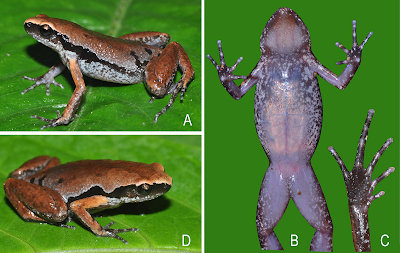 |
| Micryletta aishani
Das, Garg, Hamidy, Smith & Biju, 2019
|
Abstract
We describe a new species of frog in the microhylid genus Micryletta Dubois, 1987 from Northeast India based on molecular and morphological evidence. The new species, formally described as Micryletta aishani sp. nov., is phenotypically distinct from other congeners by a suite of morphological characters such as brown to reddish-brown dorsum; dorsal skin shagreened with minute spinules; snout shape nearly truncate in dorsal and ventral view; a prominent dark streak extending from tip of the snout up to the lower abdomen; ash-grey mottling along the margins of upper and lower lip extending up to the flanks, limb margins and dorsal surfaces of hand and foot; tibiotarsal articulation reaching up to the level of armpits; absence of outer metatarsal tubercles; and absence of webbing between toes. Phylogenetic relationships within the genus are inferred based on mitochondrial data and the new taxon is found to differ from all the recognised Micryletta species by 3.5–5.9% divergence in the mitochondrial 16S rRNA. The new species was found in the states of Assam, Manipur, and Tripura, from low to moderate elevation (30–800 m asl) regions lying south of River Brahmaputra and encompassing the Indo-Burma Biodiversity Hotspot. The discovery validates the presence of genus Micryletta in Northeast India based on genetic evidence, consequently confirming the extension of its geographical range, westwards from Southeast Asia up to Northeast India. Further, for nomenclatural stability of two previously known species, Microhyla inornata (= Micryletta inornata) and Microhyla steinegeri (= Micryletta steinegeri), lectotypes are designated along with detailed descriptions.
Micryletta aishani sp. nov.
Northeast Indian Paddy Frog
Etymology. The species epithet, aishani, is an invariable feminine noun derived from the Sanskrit word ‘aishani’ or aiśānī (meaning north-east), referring to the Northeast regions of India where this frog was discovered.
Diagnosis. The new species is assigned to the genus Micryletta due to the following combination of morphological traits: small body size (SVL 22–28 mm); absence of vomerine teeth; prominent subarticular tubercles on fingers and toes; finger and toe tips slightly expanded in to small discs; and absence of webbing between fingers and toes (Dubois, 1987; Fei et al., 2009). Micryletta aishani sp. nov. differs from the other recognised species of the genus by the following suite of morphological characters: relatively small adult size (SVL 22.1–23.5 mm, male, N = 7; SVL 25.6–27.3 mm, female, N = 4); slender body; snout nearly truncate in dorsal and ventral view, acute in lateral view; tibiotarsal articulation reaching up to the level of armpit when stretched forward along the body axis; dorsal skin shagreened with minute spinules; outer metatarsal tubercles absent; webbing between toes absent; dorsum brown to reddish-brown with a faint brown median band extending from margins of the upper eye lids and tapering up to the vent, and few scattered blackish-brown spots on posterior parts of the back and near the groin; lateral surfaces of head blackish-brown; prominent blackish-brown streak extending from tip of the snout up to lower abdomen; ash-grey mottling along the margins of the upper and lower lip, extending up to the flanks and the limb margins; anterior and posterior parts of thigh, tarsus, and dorsal surfaces of hand and foot brown with ash-grey mottling; iris bicoloured, upper half light brown and lower half dark brown; belly ash-grey with a purplish tinge and brown mottling towards the margins.
 |
| Known distribution of Micryletta aishani sp. nov. in Northeast India. |
Distribution and natural history. Micryletta aishani sp. nov. is currently known from three Northeast Indian states of Assam, Tripura, and Manipur (Fig. 1). At the type locality (Subhong), we came across a large aggregation of calling males in the month of May at around 8.30 pm. Individuals were calling from waterlogged fern banks located at the base of a small valley between hillocks (locally called Tillas). The area is characterised by degraded forest with areca nut plants and beetle vine cultivation located close to a human settlement (∼1 km). Two females were collected from the exposed slopes of the tillas close to the congregation. The species seems to have a narrow breeding season with very specific requirements as we failed to record any individuals either before waterlogging (during early April) or once the fern banks began to submerge in water (by June). Among other anurans in the same habitat, we recorded Microhyla mymensinghensis Hasan, Islam, Kuramoto, Kurabayashi, and Sumida, Kurixalus sp., Rhacophorus smaragdinus Blyth, Raorchestes sp., and Humerana humeralis Boulenger. At Tripura and Manipur, individuals were collected from ground or leaf litter near shallow streams and marshy areas covered with thick vegetation. Collection sites were located in degraded secondary forest areas close to human settlement.
 |
| Type localities of previously known Micryletta taxa from Southeast and East Asia, and the new species from Northeast India. |
Conclusions:
Our description of a new species of Micryletta from Northeast India contributes to a better understanding of the diversity in this genus. The discovery also genetically validates the presence of the genus Micryletta in India and the westward extension of its geographical range within South Asia. The study provides evidence for genotypic and phenotypic distinctness of the new species from all the previously recognised congeners, designates lectoptypes for nomenclatural stability of two previously known species, and confirms the presence of additional undescribed lineages within the genus. Altogether, our work will facilitate future taxonomic, phylogenetic, and biogeographical studies in this microhylid group.
Abhijit Das, Sonali Garg, Amir Hamidy, Eric N. Smith and S. D. Biju. 2019. A New Species of Micryletta Frog (Microhylidae) from Northeast India. PeerJ. 7:e7012. DOI: 10.7717/peerj.7012




